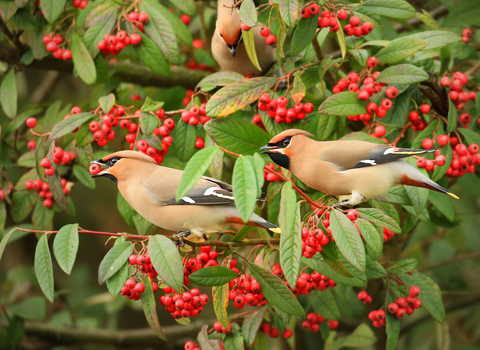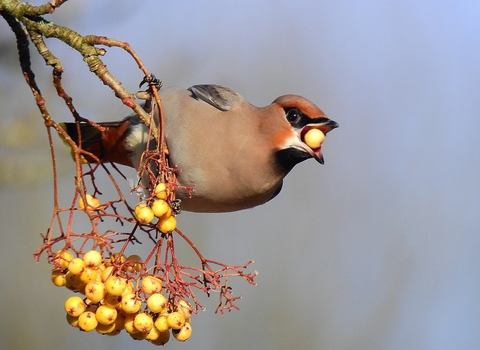
©Jon Hawkins Surrey Hills Photography
Waxwing
The waxwing is a colourful winter visitor. It can often be spotted in large flocks in berry-laden bushes in towns, car parks and gardens.
Scientific name
Bombycilla garrulusWhen to see
October to MarchSpecies information
Statistics
Length: 18cmWingspan: 34cm
Weight: 63g
Classified in the UK as Green under the Birds of Conservation Concern 5: the Red List for Birds (2021).
Habitats
About
A starling-sized bird, the waxwing is one of the UK's most exotic-looking birds, with a large, orangey-pink crest. It does not breed in the UK, but is a winter visitor from Northern Europe and can be spotted in flocks on bushes full of berries - it isn't fussy where the bushes are and frequents towns, car parks and gardens. Waxwings prefer rowan and hawthorn berries, but can be enticed with hung-up apples. Sudden invasions of large numbers of waxwings (called 'irruptions') occur when the berry crops fail in Northern Europe.How to identify
The waxwing has a pink crest and breast, a black mask and throat, a grey rump, a black tail that is tipped with bright yellow, and yellow-and-white markings on its wings.Distribution
A rare winter visitor which can turn up anywhere, particularly in the north and east of the country.Did you know?
Waxwings tend to prefer eating red berries to orange berries; but they will choose the latter over yellow and white ones. This pattern is seen in many other berry-eating birds. One downside of eating so many berries is that the birds sometimes become a bit intoxicated by fermenting fruit.Watch
Waxwings (https://vimeo.com/453714136)
Waxwings by Jack Perks

Bohemian waxwing
Spotted in Burnley by Jen Coates
The wonder of waxwings
Discover more about these beautiful birds, and our tips for some of the best places in the North West to look out for them.

Bohemian waxwing
Spotted in Burnley by Jen Coates
The wonder of waxwings
Discover more about these beautiful birds, and our tips for some of the best places in the North West to look out for them.
